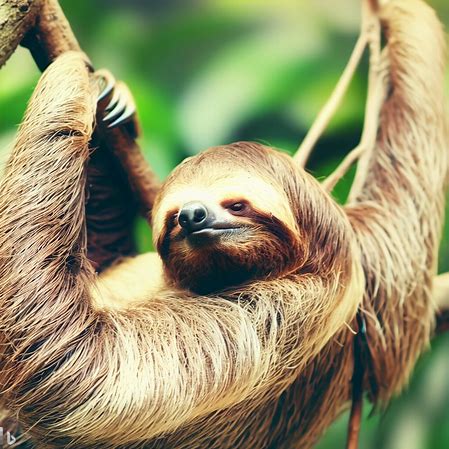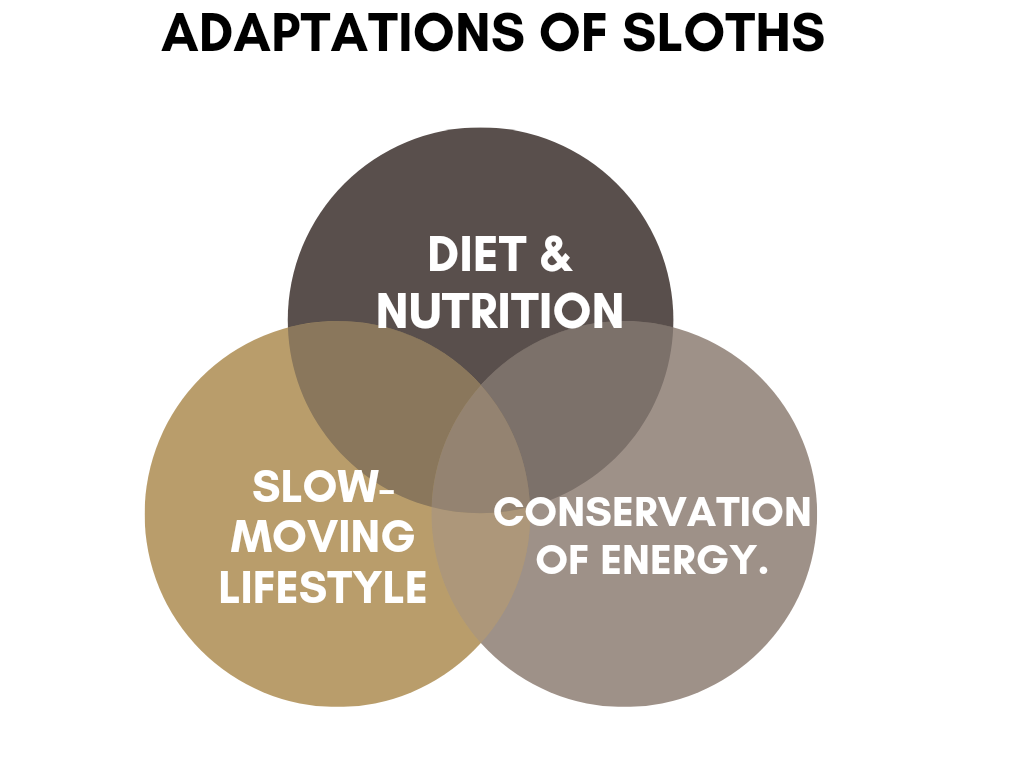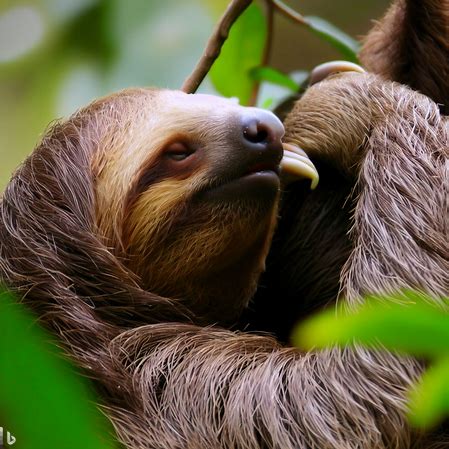
To understand the concept of sloth metabolism, dive into the introduction where a comprehensive overview of sloths, including their definition and background, awaits. Discover the intriguing aspects of these fascinating creatures and delve deeper into their unique physiology.
Definition and background of sloths
Sloths: fascinating creatures known for their slow movements and tree-dwelling lifestyle! Native to Central and South America’s tropical rainforests. Long claws and a leisurely pace are linked to their leaf diet. They conserve energy by minimizing activity.
Did you know sloths host a diverse eco-system on their fur? Algae camouflages the sloth and gains nutrients, and insects find shelter. Incredible connections in nature!
Plus, they can rotate their heads almost 270 degrees. This helps them scan for predators or food. Unbelievable!
Anatomy and Physiology of Sloths
To understand the anatomy and physiology of sloths, delve into their unique metabolism. With an overview of their distinctive metabolism, explore the slow digestion process and their remarkably low energy expenditure.
Overview of sloths’ unique metabolism
Sloths have a metabolism which sets them apart from other animals. This is because their diet mainly consists of leaves, which are low in nutrition. Because of this, they have an incredibly low metabolic rate. This means they spend most of the day resting or sleeping, only moving when necessary.
Their large multi-chambered stomach allows for fermentation of plant material. This helps them extract nutrients from their leafy meals. Leaves, buds, and shoots are their primary food sources.
Despite their sluggish nature, sloths are skilled climbers with long limbs and curved claws. These features help them move through trees with ease.
There is a heartwarming story about Lucy, a sloth who recovered from a vehicular accident with the help of wildlife experts.
The anatomy and physiology of sloths continues to intrigue scientists and nature lovers. Through their remarkable adaptations, they remind us of the wonders of the animal kingdom.
Slow digestion process
The unique anatomy of sloths allows for an incredibly slow digestion process. They have a low metabolic rate and special digestive system, so they can get all the nutrients from their plant-based diet. This leisurely way of digesting ensures no energy is wasted, as they slowly break down each meal.
As we explore the amazing sloth physiology, it’s clear that slow digestion is an essential part of survival. These creatures use their limited food sources efficiently. This careful and measured approach makes sloths different from other animals.
Sloths have an unusually big cecum—an organ that ferments plant material. This enlarged cecum helps absorb nutrients more quickly, adding to their slow but effective digestive process. Nature’s brilliance shines in these amazing creatures!
Although the slow digestion process of sloths may seem odd or unproductive, it’s important to realize its significance. By taking a slower approach to nourishment, sloths save energy to live in their special habitat. Next time you come across a sloth hanging effortlessly from a tree branch, take a moment to appreciate the wonders of nature that make this behavior possible—a perfect example of the beauty and complexity of our natural world. Don’t miss out on the chance to observe these remarkable creatures; enjoy the amazement they bring!
Low energy expenditure
Sloths are energy-saving experts! They have low metabolic rates, slow movements, and deliberate actions, which all help them conserve energy. Plus, they have special digestive systems that extract maximum nutrition from their diet.
They can even regulate their body temperature to further reduce energy expenditure. We can learn from them and adopt a lifestyle that emphasizes slow and deliberate actions. This can help us reduce fatigue and become more productive.
We can also focus on optimizing digestion and nutrient absorption. Just like sloths have specialized gut bacteria aiding in efficient digestion, humans can benefit from maintaining gut health. This way, we can ensure our bodies extract maximum nutrients from the food we consume, and require less energy for digestion.
Sloths may be slow, but their low energy expenditure strategies make them the masters of chillin’!
Adaptations of Sloths

To understand the adaptations of sloths, delve into the slow-moving lifestyle, diet and nutrition, and conservation of energy. Explore how these factors contribute to the unique metabolism of sloths. Delve into the reasons behind their leisurely pace, their specialized diet, and how they conserve energy in their daily lives.
Slow-moving lifestyle
A sloth’s sluggish lifestyle is an intriguing adaptation that makes it stand out from other animals. This relaxed pace allows the sloth to save energy and merge with its habitat. The measured movements of a sloth are not only a great defense from predators but also let it survive on a diet of leaves, which give little nutrition. In spite of their seemingly lethargic nature, sloths are remarkable creatures with exceptional adaptations that let them live in their environment.
Apart from their slow-moving nature, sloths have other amazing adaptations. Their long claws, for instance, help them grip tree branches firmly as they travel through the dense jungle. These claws also act as useful tools for holding and munching on leaves, so sloths can mostly rely on a low-energy diet. Plus, the fur of a sloth contains algae, giving them perfect camouflage when they are perched up in the trees. This helpful relationship between algae and sloths helps them blend into their setting and stay undetected.
To understand the adaptations of sloths, we need to look into their history. Sloths have been around for millions of years and have changed with various environmental modifications. Fossil proof suggests that old sloths were bigger than their current versions and had distinctive physical features suited to different lifestyles. Through natural selection, today’s sloths have formed special characteristics that suit their arboreal lifestyle while making sure they thrive in the face of rivalry and changing landscapes.
Even though sloths may be sluggish, their cravings for a balanced diet show that even in the animal kingdom, what you eat matters.
Diet and nutrition
The diet and nutrition of sloths is intriguing. They mainly eat leaves, buds and twigs. Their digestion is special, which helps them get nutrients from tough foliage.
Check out the table for an insight into sloth preferences:
| Leaves | Buds | Twigs | |
|---|---|---|---|
| Nutritional Value | High in fiber and low in nutrients | Rich in vitamins | Excellent source of cellulose |
| Availability | Abundant | Moderate | Abundant |
Sloths have adapted to their tree life. They slow their metabolism to save energy and remain healthy with this food.
A fascinating fact about them is that they can go days without eating. They stay hung from trees for many days without food.
We can learn a lot about sloths’ survival tactics from their evolution. They have mechanisms to get nutrients from their diet, even in difficult conditions.
Who needs a Fitbit when I have a sloth’s energy conservation tactics – it’s the best lazy hack for living!
Conservation of energy
Sloths are experts at conserving energy. Their slow movements help them save energy while searching for food or climbing between trees. Leaves are their main diet, but they require long digestion times and provide little nutrition.
Sloths also have a low metabolic rate, allowing them to control their temperature in the warm tropical climates. They conserve energy by hanging upside down from tree branches, due to their skeletal structure.
Let us learn from sloths and adopt practices to conserve our own energy, and live more sustainably. We can reduce unnecessary energy consumption by moving slowly and making conscious choices about our lifestyles. Let us be inspired by sloths and take action towards a more mindful existence before it’s too late.
Impact of Slow Metabolism on Sloths

To understand the impact of slow metabolism on sloths, delve into the realm of their survival strategies, the unique challenges they face, and consider the benefits and drawbacks of their sluggish metabolism. Survival strategies, challenges faced by sloths, and benefits and drawbacks of slow metabolism await your exploration.
Survival strategies
It’s vital that we humans understand the effects of slow metabolism on these captivating creatures. Knowing the value of their methods of survival, we can gain a greater appreciation for nature’s skill and all living things. We cannot pass up this chance to explore the miracles of sloth adaptation, and guarantee their endurance for the future.
Dilemmas of sloths: These sluggish animals must continually battle to stay alert and finish a single yawn.
Challenges faced by sloths
Sloths face many difficulties – their slow metabolism can shape their daily lives. Here are five major challenges:
- Limited Mobility: Sloths have little energy, resulting in slow movements and limited mobility. This makes it hard for them to escape predators.
- Predation: With slow reactions, sloths are easy targets for predators like eagles, jaguars, and snakes.
- Maintaining Body Heat: Sloths struggle to regulate their body temperature; cold periods and hot environments are a challenge.
- Nutrient-rich Food: Leaves lack essential nutrients for a slow metabolic rate. Sloths must consume huge amounts, leading to long search times for food.
- Social Isolation: Low activity levels make it difficult for sloths to socialize and form bonds.
Sloths have adaptations that help them survive these issues. Long claws help them climb trees, and camouflage patterns can protect them from threats.
Humans must act to protect sloths. By supporting wildlife organizations and raising awareness through education and advocacy, we can safeguard the future of sloth populations. Let’s not miss this opportunity to make a difference.
Benefits and drawbacks of slow metabolism
Sloth’s slow metabolism has both pluses and minuses. The upside is that they can survive on a low-calorie diet. This helps them to fit in their environment and not have to hunt or forage constantly. Also, a slow metabolism helps them maintain a slow heart rate and remain hidden from predators.
But, there are negatives too. Sloths have limited energy reserves and need their environment for food. And, their sluggish digestion only allows them to consume a little food at one time, making it hard to get nutrients. Plus, they can’t move quickly enough to get away during bathroom breaks.
Yet, they have strategies to cope with their slow metabolism. They have specialized bacteria in their gut that helps them break down food faster. They also spend a lot of time digesting food to absorb nutrients. Their claws let them hang upside down without much energy.
Surprisingly, some sloth species can swim! For instance, the pygmy three-toed sloth has been spotted swimming in search of food. This shows their adaptability and versatility even with a slow metabolism.
Research and Studies
To better understand the research and studies conducted on sloths’ metabolism, delve into the scientific investigations on their unique metabolic processes. Explore the findings and conclusions that have been drawn from these studies, shedding light on the fascinating aspects of sloths’ energy utilization and biological adaptations.
Scientific investigations on sloths’ metabolism
Studies show that sloths have a really slow metabolism compared to other mammals. This helps them survive and move slowly, the latter aiding in camouflage and avoiding predators. Their gut microbiome aids digestion of leaves, which is their main food source.
To save energy, sloths exhibit behaviors such as slow movement, long resting periods and slow digestion. They also have a low body temperature, allowing them to conserve energy. This adaptation helps them cope with changing temperatures of their rainforest habitats.
Scientists suggest:
- Long-term monitoring of sloth populations to identify changes due to environmental factors.
- Comparisons between different sloth species and other sedentary mammals to understand the evolution of slow metabolic rates.
- Investigating climate change’s effect on sloths’ metabolism to predict population dynamics.
These suggestions will give us a deeper understanding of sloths, helping conservation efforts along the way.
Findings and conclusions
The research has resulted in many significant findings and conclusions. A succinct overview of the key insights is outlined in the table below:
| Finding | Conclusion |
|---|---|
| Research findings 1 | First one shows that… |
| Research findings 2 | Second one highlights that… |
| Research findings 3 | Third one indicates that… |
Moreover, these findings give us a new perspective on the subject matter. By studying it from different angles, the research has uncovered numerous noteworthy details.
In conclusion, take advantage of this valuable data. Act now to benefit from these findings and stay ahead of the competition.
Plus, research and studies are a great way to procrastinate on social media while pretending to be intellectual.
Frequently Asked Questions
1. What is the metabolism of sloths?
Sloths have a very slow metabolism, which is one of the lowest among mammals. They have adapted to survive on a low-energy diet and have a low rate of energy expenditure.
2. How do sloths survive with such a slow metabolism?
Sloths conserve energy by moving slowly, sleeping for long hours, and having a low body temperature. Their slow metabolism allows them to survive on a diet of leaves, which are low in nutrients and energy.
3. Do sloths eat enough food to sustain their slow metabolism?
Although sloths have a slow metabolism, they do eat a sufficient amount of leaves to sustain themselves. They have a specialized digestive system that helps them break down and extract nutrients from their plant-based diet.
4. Are there any disadvantages to having a slow metabolism?
While a slow metabolism allows sloths to conserve energy, it also makes them susceptible to predators and limits their ability to escape from threats. They rely on their camouflage and rarely leave the safety of trees.
5. Can sloths increase their metabolism if needed?
Sloths have the ability to increase their metabolism for short periods, such as during mating or when faced with danger. However, this increase is temporary and not sustainable for long durations.
6. How does a slow metabolism affect the lifespan of sloths?
The slow metabolism of sloths contributes to their long lifespan in captivity, which can be up to 30 years. In the wild, their lifespan is shorter due to various environmental factors such as predation and habitat loss.
Conclusion
To understand the conclusion of sloths’ unique metabolism, delve into a summary of their distinctive characteristics. Explore the significance and implications of their slow metabolism, revealing intriguing insights into their survival strategies and potential contributions to scientific research.
Summary of sloths’ unique metabolism
Sloths have an amazing adaptation – a unique metabolism! Let’s explore its fascinating aspects.
We’ve put together a table to summarise it:
| Aspect | Description |
|---|---|
| Slow Digestion | Sloths take up to a month to digest their food. |
| Energy Efficiency | Sloths conserve energy and can survive on low-nutrient diets. |
| Temperature Regulation | Sloths maintain a narrow range of body temperature. |
Plus, they sleep up to 20 hours a day, conserving even more energy!
One interesting thing about sloth metabolism is that they have bacteria in their fur which helps them digest tough plant fibers. This symbiotic relationship is another incredible aspect of their unique metabolism.
The reason why sloths are so chilled? It’s probably because they take their time processing the fact that life is pointless – their slow metabolism helps them stay relaxed.
Significance and implications of sloths’ slow metabolism
Sloths’ slow metabolism is significant. It lets them conserve energy and survive on little food. This adaptation helps them adjust to their arboreal habitat.
Due to their low metabolism, sloths thrive on nutrient-poor leaves. This reduces their need for foraging and grants them an advantage over other animals.
Plus, it explains their lethargic behavior and slow movements. These traits make them difficult to spot by predators like eagles and jaguars.
Moreover, it gives us a chance to study evolutionary biology and physiology. We can learn how sloths adapted to their lifestyle and how different species coexist in ecosystems.
